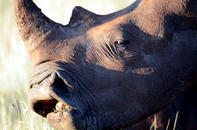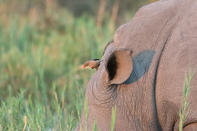Neck and Horns

White rhino have massive necks with a large nuchal hump over the shoulders. The thick albeit short neck supports the large head which is held low to the ground in order for the rhino to feed on the lowest-lying form of vegetation, grass.
Having its head close to the ground also facilitates the use of its nostrils to detect olfactory (scent-related) clues regarding territory and the location of other rhino. Rhino rely on their sense of smell since eyesight is limited. The powerful neck also provides the force behind the defensive horns. The most prominent feature of the rhino is its horns.
These are weapons of defence used to protect itself and its offspring from predators or during bouts of combat. Horns are made of keratin (the same substance as fingernails) and grow 2-6 cm in a year and continue to grow throughout life. They are often worn down through usage and tend to be longer and thinner in cows which do not engage them as frequently as the bulls. The record horn length for a white rhino is 1.58 m.
Good Hearing

Rhinos have relatively poor eyesight and can only really see well at close range. They do however respond to movement at greater distances. To compensate, the senses of hearing and smell are very well developed and both are employed for the purposes of communication and detecting danger.
A rhino’s ears are constantly moving rotating independently in all directions to collect auditory clues. When a sound is detected, both ears focus in that direction. The ears are conveniently placed atop the long head to collect sounds while the low slung muzzle is optimally placed to smell.
By Megan Emmett